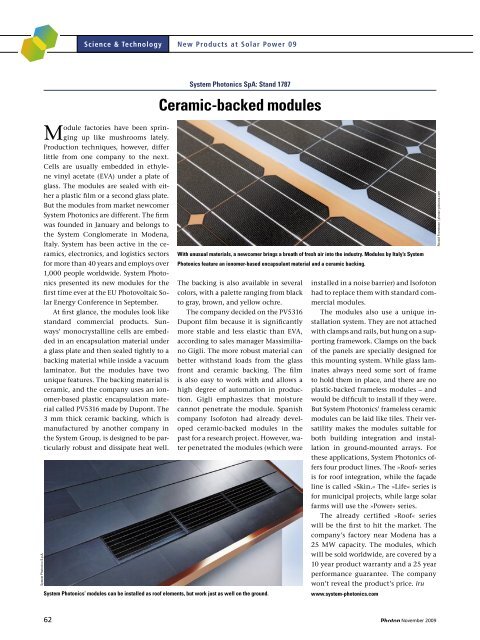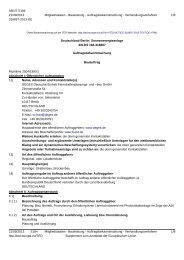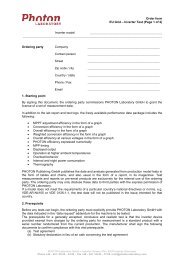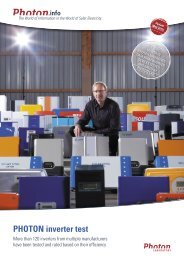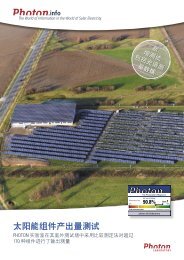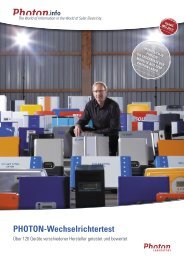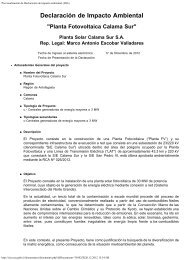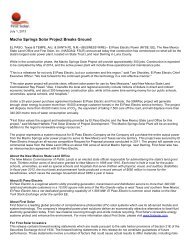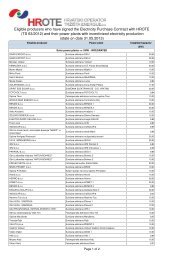INTRODUCTORY SPECIAL INTRODUCTORY ... - PHOTON Info
INTRODUCTORY SPECIAL INTRODUCTORY ... - PHOTON Info
INTRODUCTORY SPECIAL INTRODUCTORY ... - PHOTON Info
Create successful ePaper yourself
Turn your PDF publications into a flip-book with our unique Google optimized e-Paper software.
System Photonics S.p.A.<br />
62<br />
Science & Technology<br />
Module factories have been springing<br />
up like mushrooms lately.<br />
Production techniques, however, differ<br />
little from one company to the next.<br />
Cells are usually embedded in ethyle-<br />
ne vinyl acetate (EVA) under a plate of<br />
glass. The modules are sealed with eit-<br />
her a plastic film or a second glass plate.<br />
But the modules from market newcomer<br />
System Photonics are different. The firm<br />
was founded in January and belongs to<br />
the System Conglomerate in Modena,<br />
Italy. System has been active in the ce-<br />
ramics, electronics, and logistics sectors<br />
for more than 40 years and employs over<br />
1,000 people worldwide. System Photo-<br />
nics presented its new modules for the<br />
first time ever at the EU Photovoltaic So-<br />
lar Energy Conference in September.<br />
At first glance, the modules look like<br />
standard commercial products. Sun-<br />
ways’ monocrystalline cells are embed-<br />
ded in an encapsulation material under<br />
a glass plate and then sealed tightly to a<br />
backing material while inside a vacuum<br />
laminator. But the modules have two<br />
unique features. The backing material is<br />
ceramic, and the company uses an ion-<br />
omer-based plastic encapsulation mate-<br />
rial called PV5316 made by Dupont. The<br />
3 mm thick ceramic backing, which is<br />
manufactured by another company in<br />
the System Group, is designed to be par-<br />
ticularly robust and dissipate heat well.<br />
New Products at Solar Power 09<br />
System Photonics SpA: Stand 1787<br />
Ceramic-backed modules<br />
System Photonics’ modules can be installed as roof elements, but work just as well on the ground.<br />
With unusual materials, a newcomer brings a breath of fresh air into the industry. Modules by Italy’s System<br />
Photonics feature an ionomer-based encapsulant material and a ceramic backing.<br />
The backing is also available in several<br />
colors, with a palette ranging from black<br />
to gray, brown, and yellow ochre.<br />
The company decided on the PV5316<br />
Dupont film because it is significantly<br />
more stable and less elastic than EVA,<br />
according to sales manager Massimilia-<br />
no Gigli. The more robust material can<br />
better withstand loads from the glass<br />
front and ceramic backing. The film<br />
is also easy to work with and allows a<br />
high degree of automation in produc-<br />
tion. Gigli emphasizes that moisture<br />
cannot penetrate the module. Spanish<br />
company Isofoton had already devel-<br />
oped ceramic-backed modules in the<br />
past for a research project. However, wa-<br />
ter penetrated the modules (which were<br />
installed in a noise barrier) and Isofoton<br />
had to replace them with standard com-<br />
mercial modules.<br />
The modules also use a unique in-<br />
stallation system. They are not attached<br />
with clamps and rails, but hung on a sup-<br />
porting framework. Clamps on the back<br />
of the panels are specially designed for<br />
this mounting system. While glass lam-<br />
inates always need some sort of frame<br />
to hold them in place, and there are no<br />
plastic-backed frameless modules – and<br />
would be difficult to install if they were.<br />
But System Photonics’ frameless ceramic<br />
modules can be laid like tiles. Their ver-<br />
satility makes the modules suitable for<br />
both building integration and instal-<br />
lation in ground-mounted arrays. For<br />
these applications, System Photonics of-<br />
fers four product lines. The »Roof« series<br />
is for roof integration, while the façade<br />
line is called »Skin.« The »Life« series is<br />
for municipal projects, while large solar<br />
farms will use the »Power« series.<br />
The already certified »Roof« series<br />
will be the first to hit the market. The<br />
company’s factory near Modena has a<br />
25 MW capacity. The modules, which<br />
will be sold worldwide, are covered by a<br />
10 year product warranty and a 25 year<br />
performance guarantee. The company<br />
won’t reveal the product’s price. iru<br />
www.system-photonics.com<br />
November 2009<br />
Ronald Frommann / photon-pictures.com


